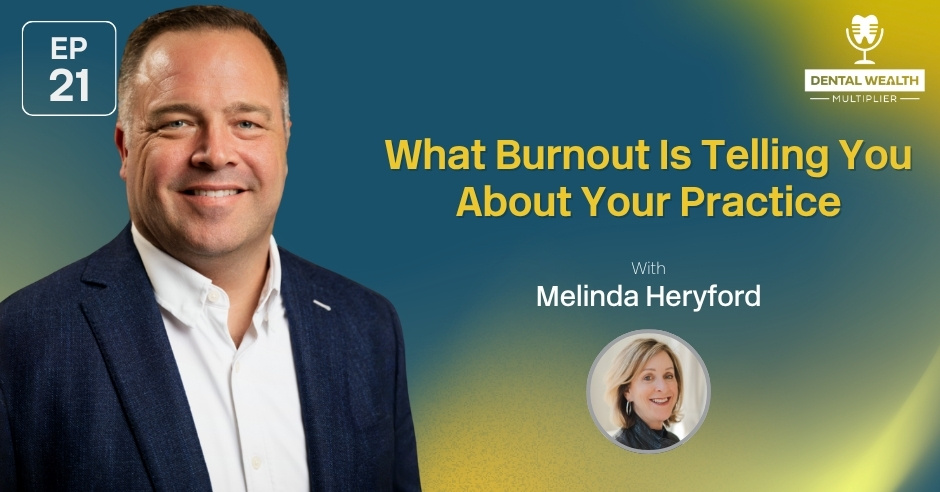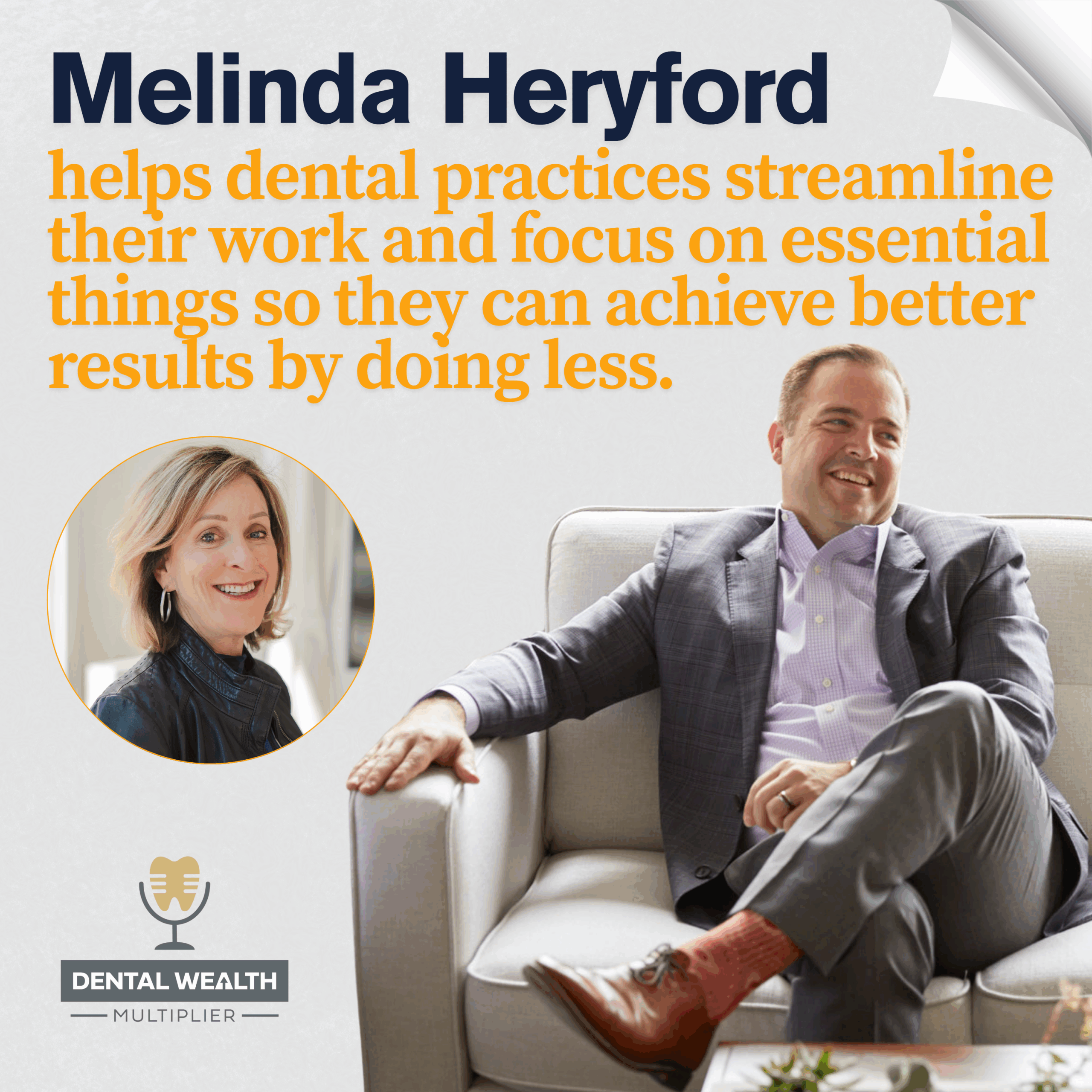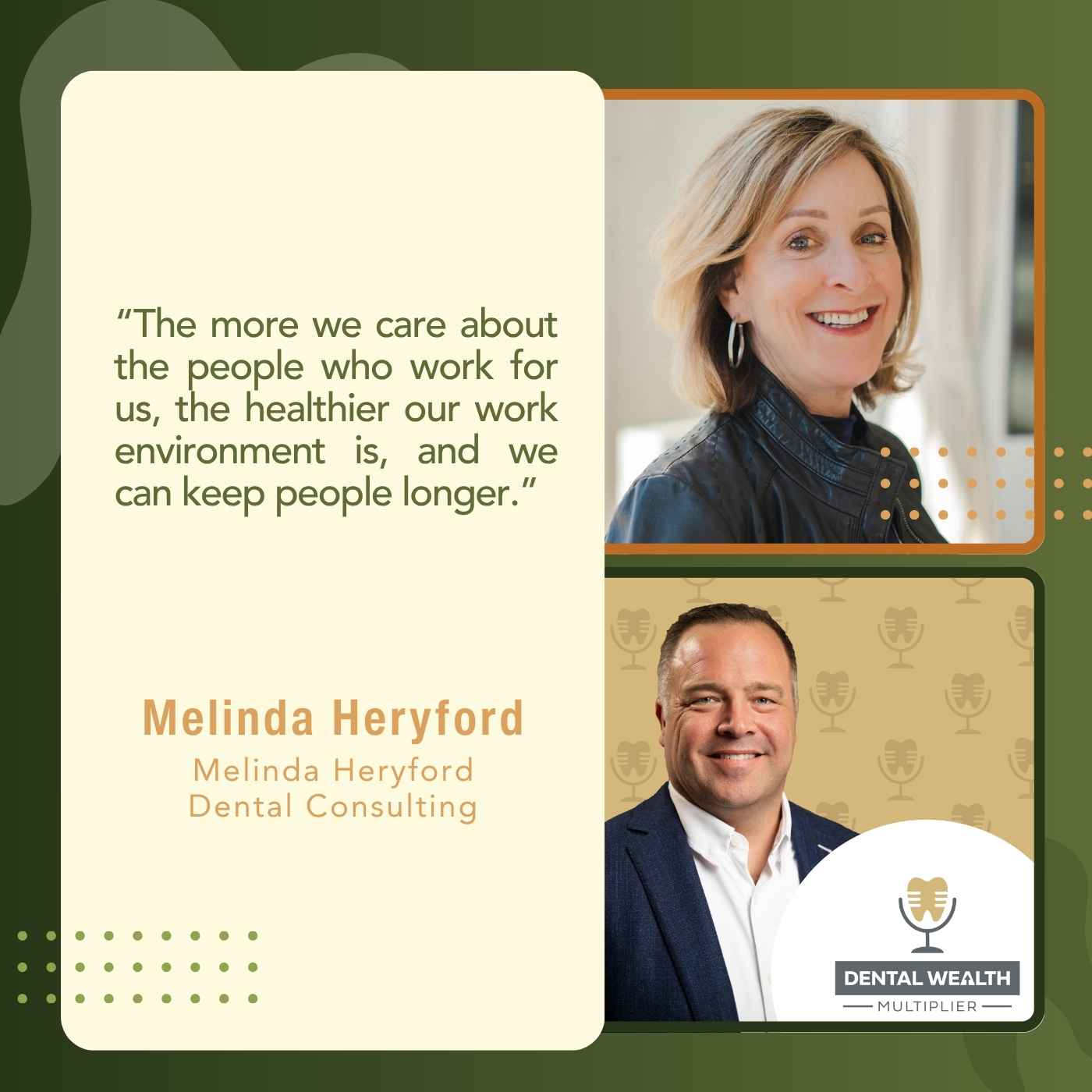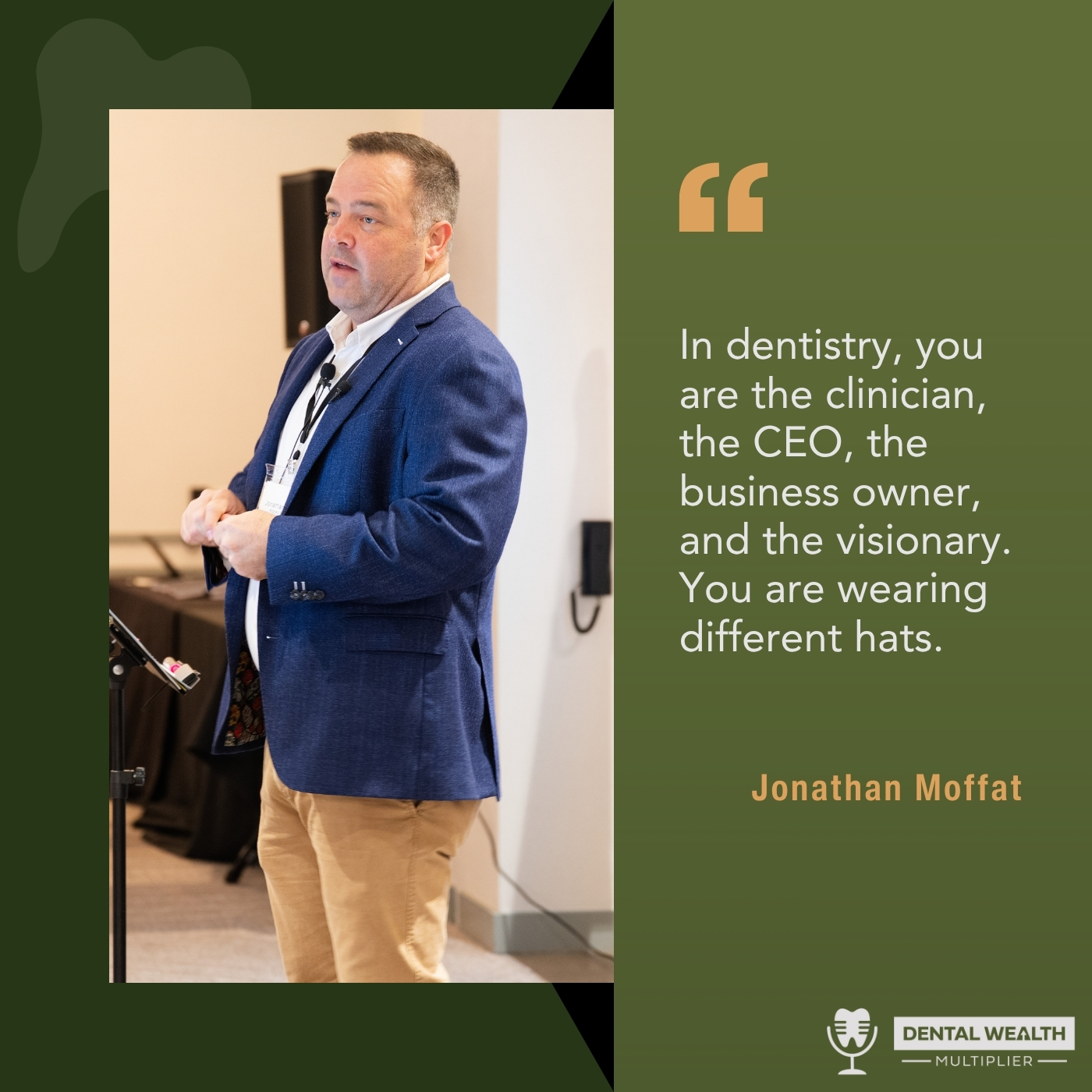
Jonathan Moffat sits down with strategist and coach Melinda Heryford to talk about what burnout is really trying to tell you and how to design a practice that runs smoothly, not just harder. From chaotic schedules to leadership gaps, they unpack the root causes of stress for owner-operators and how to shift from survival mode into a sustainable, system-driven practice. Melinda also shares the six key systems she uses to streamline operations and the mindset shift every dentist need before adding an associate. If you have ever felt stuck, exhausted, or unsure how to grow without burning out, this episode is your signal to pause and reset.
Find Jonathan at jonathanmoffat.com
Learn more about Aligned Advisors at alignedadvisors.com
Connect with Melinda at https://practicemanagementconsulting.com
Find Jonathan on LinkedIn: linkedin.com/in/jonathanmoffat1
Find Melinda on LinkedIn: https://www.linkedin.com/in/melindaheryford
Build a business that supports the life you actually want.
Catch new episodes weekly and dive deeper at dentalwealthmultiplier.com
—
Watch the Episode here
Listen to the Podcast here
What Burnout Is Telling You About Your Practice With Melinda Heryford
Welcome to another episode of Dental Wealth Mastermind. I’m Jonathan Moffat, and with me is a special guest, Melinda Heryford. Melinda, it’s so great to have you here. I know we talked about doing this weeks ago, so thanks for making the time to come on here and share your expertise and perspective.
It’s my pleasure to do this, Jonathan. I’m excited to have this conversation and you explore this topic.
I’ll give the audience a brief bio on you so they know your background and area of expertise. Melinda is a visionary strategist and coach with over four decades of experience transforming dental practices. She’s a creator of the Prime Journey Process™, a proven system that brings clarity, synergy, and profitability to dental teams.
Melinda helps practice owners build operations that run smoothly, teams that work together, and businesses that grow with purpose. That’s pretty awesome. We do regular Mastermind calls and calls with clients, and those are all things that everyone wants to talk about and learn more about, so I’m excited to have you on, Melinda. I think we met back in February 2025 at a dental meeting with a bunch of dental colleagues of ours. When I heard you introduce yourself, I was like, “I need to learn a little bit more about what Melinda is doing and how she is helping and serving her clients.” I’m glad to be able to share that with the people.
Thank you, Jonathan. I think about it as being like-minded. I feel like you and I are like-minded. What we see is possible for a dental practice, and also understanding what people are dealing with day-to-day.

Strategist And Coach Melinda Heryford
Let’s get into that. Maybe give a little bit of perspective on who you’re working with. Who’s the typical dentist that Melinda is working with or talking to? What do they look like?
Thanks for asking. I’ve been at it for a while. Our niche is working with doctors that are hovering around a million, typically solo practitioners, and they are interested in going to $3 million or $5 million in that journey to get there, which you know how that works. It’s a process of systems and adding different providers. That is our home zone, our niche. It’s a fascinating thing because I’m a business person. I’ve been in dentistry since I was fourteen. I’m also a dental person. I’ve been at it in our field for a long time.
I have compassion for and get the clinical side of what we do and the day-to-day side. I had experience, as you do, as an operator, being in the trenches, as we say, in the day-to-day. As a business person, I’m always focused on, “How can we make this practice better? How can it be better?” That’s my ongoing tape. You’re probably like this, too. You look at it and you’re like, “What’s possible here?” It is an interesting thing because there is a delicate balance.
With doctor owners or operators, what I am finding is that they are stressed. Some of them are burned out because of the day-to-day grind. Every day that they show up, there’s either team members missing or out sick, or patients canceling, or we need this or that. They’re being tugged on from all different angles. That idea of being a CEO of their practice is far from what they even have energy for.
That’s the state of the nation when I walk in. It scares them to think about doing more because they’re struggling to do what they’re doing and feeling exhausted. The Thursday night hits, most of the doctors that I work with work four days a week. The first Thursday hits, and they don’t even want to think about it until 9:00 in the morning. There’s a role and a treadmill that they’re on that makes them tired and exhausted.
How do they get out of that? I would agree with you. We’ve talked about this before. I don’t know that it’s a dental-specific issue. I’ve found myself being that way with my business, and I love what I do. I found myself also getting into those times where I feel burned out. You get to Sunday evening and you’re like, “Tomorrow is Monday.” You have that thought. I’ve felt like that before. I’ve also had times where a Sunday night comes around and I’m like, “I can’t wait for tomorrow morning. It’s going to be amazing.”
Doctors and practice owners are stressed and burned out by the day-to-day grind. They are being tugged on from different angles. Share on XStreamlining Processes And Schedules
That’s the groove that I’m in right now. Things are great. How do you work with the doctors or help coach them through getting through that burnout and getting through that feeling of overwhelm, and almost like I’m on this treadmill, and how much longer am I going to have to do this? Whether it’s struggling with like, “The practice isn’t growing, or my team doesn’t seem to be working together as well as they used to be in the past.” Where do you start? How do you help the doctor start to identify where that’s coming from? What’s that process to help them start chipping away and making some forward movement in progress towards that?
From a business perspective, we know that streamlining things. It’s the same when we deliver clinical dentistry. If you did the same procedure differently every single time, it wouldn’t be very efficient. Doctors inherently know that because they’re trained to be efficient in each of the procedures that they do. The interesting thing is that it doesn’t necessarily translate to the rest of the practice. We were having this conversation at Dental Collective. It’s like, what are the standards? The standards don’t necessarily translate from a business point of view or from an operational point of view.
Our proven process was designed and honed to address the 20% of the 80% that makes the difference. Streamlining the schedule, the daily flow, and the communication so that each interaction with the patient, every team member knows their role. They know the most important pieces that they’re supposed to touch in that patient interaction, so that they can do their part. Everybody else can do their part, and it results in the patient saying yes to care.
It is this idea of streamlining the schedule. The schedule isn’t about doing more, as you know. It’s about doing things more effectively. In general dentistry, we have to do a certain variety of procedures, but the way we put those together in the schedule can either make a day flow well or make a day crazy busy. You’ve heard doctors say this, Johnathan. It’s like, “If we can light up that day, every day, I’d be a happy camper.” It’s when they’re more productive, typically, optimizing the schedule. We talk about that, but it’s like, how do we do that, and then reproduce that every single day? That’s the piece.
We’ve honed it down to six systems that we pay attention to and that we streamline. We’re addressing other pieces also, but if we can nail those six systems, each team member can show up, know what their primary responsibilities are, and know what they need to nail. It’s usually 2 or 3 things, Jonathan. It’s not a hundred. When they nail it and every team member is nailing their most important things, then the days go smoothly. It is a miracle. You’ve seen it, Jonathan. You’ve seen some days. It’s like, you were the special clothes, and everybody knows their financial arrangement, and we collect as we go. The insurance comes out right because we put everything in the computer correctly.
Practice owners must create something they do not have to be in. It must be self-sustaining and not dependent on them. Share on XThe treatment came out right because everything was there and set up exactly as we needed. Everybody nailed it for every single patient, and that’s when life goes smoothly. That’s when it feels good. It’s also typically when they’re most productive. That’s what we focused on. It’s honing that daily flow with the patients and focusing on the essential things so that it calms the chaos and increases the result. It’s almost counterintuitive because they’re doing less to create a better result.
Essential Roles In The Practice (And How They Can Nail Their Work)
You talked about whether the team members are doing these. You said you measure six metrics. The team members are doing these 2 or 3 metrics things to generally go smoothly. Can you give us an idea of what some of those things are that they should be doing, so that the doctors have a smooth day?
For instance, the scheduling coordinator’s goal is to build an optimized, productive schedule. That is the goal, and that’s their primary responsibility. To do that, they have to make sure patients who are diagnosed with treatment come in. It’s their final responsibility. They’re not the only ones responsible for them getting to yes. The hygienists are responsible for helping to co-work with or co-diagnose. They’re with the patient the longest when a patient comes in, and they get a bird’s eye view of what’s happening, not only with perio, but the condition of the teeth and the mouth.
They’re putting that up for the doctors, so that when the doctor walks in, it’s top of mind and it’s all right there. We like the doctor to walk in and see the pictures with the patient and go, “I see that. Do you see that? Okay. Great. Let’s get that done.” Those are major rules. Those are specific. We like the assistance to nail the pass-offs, so that communication from the time that the treatment gets diagnosed, the doctor is talking about it. It gets documented, but then it comes to the front desk in a way that presents that treatment based on what’s in it for the patient.
It isn’t just like, “It went well today. This is what’s next.” It’s like, “In order to get Mrs. Jones into full form, health, and function, this is what doctors recommend next.” Those are the focal points of the patient interaction that make the difference in whether patients own and agree to getting healthy and maintained.
Building A Self-Sustaining Lifestyle Business
You said something early, and it’s been circling around in my head. You said, a lot of times the doctors experience burnout and this frustration, whether it’s with growth or can’t quite seem to get things moving in the direction they want. You said most of the doctors you work with, the same as us, what Monday through Thursday. They leave on Thursday, and they don’t want to think about the practice on Monday. When you said that, a thought came into my head. It was this idea that if you want something different or if you want a different outcome, you have to put in different work.

I don’t know what you recommend your doctors do, but I would suggest that if you’re finding yourself in that situation where you’re frustrated, feeling burned out, or things aren’t moving forward, instead of taking Friday off, spend that time looking and working on the practice. Work on the business side, which you don’t get to do during the rest of the week. If you’re chairside and your clinical, which I’m going to guess, most of your doctors are, a lot of ours are, you don’t have that time to do that.
Having that administrative day is something that we recommend a lot of our clients do. Have an administrative day or at least start with half a day. Instead of going golfing on Friday morning, maybe postpone that golf game for six months and use that time instead to work on the business. When you are talking to your doctor, how do you help coach them through that shift in mindset of, “If we want something different, we have to put in different work?” How do you work with them or talk with them?
I love that you’re bringing up working on the business versus working in the business. It goes back to when most dentists chose to be dentists; they wanted to be dentists. They didn’t want to be a CEO. It was like the booby prize. We call it a lifestyle business because it is like, “I chose this career because it’s a great lifestyle. Not because I want to be a CEO, or not because I want to be an entrepreneur.”
It’s realizing that part and also saying, “Okay. I also have this business. What is the most effective way for me to care for it, like I would care for our team members or a patient?” I think about the business like that. It is an entity that has to be cared for. I love what you’re saying, which is creating admin days to work on the practice. What I would add to that is we like to survey the team and identify the natural leaders that percolate up to the top.
We like to have leaders and champions. We like to share the responsibility of caring for the practice and managing the practice. You and I have talked about this. We’d like to create something that they don’t have to be in. Something self-sustaining that’s not doctor-dependent. Part of how to do that is to have associates for sure. They need to be able to come out of the chairside responsibility and also delegate, train, and figure out who the leaders are, or hire some leaders. They don’t come ready-made, as you know. I like that semi experience.
The longer you have been practicing, the more important it is to recreate yourself. Share on XThey don’t necessarily come ready-made. We need to work to develop leaders and departments, hygiene, clinical admin, and those areas. As you bigger, then there’s an office manager or practice administrator. It’s truly having a sustaining business that is not dependent on you. You have good systems that are duplicatable, predictable, the same, and are not constantly changing. It doesn’t have to be a massive amount.
We have systems around those seven key areas, and then train leaders to be responsible for those areas, and then bring them together. It sounds simple, but you know what it takes. It takes an awesome culture, and that’s the doctor building that awesome culture. It starts with what you’re talking about, which is that they have some time to build out. I’m okay if it’s even inside the four days. There’s some time to put their hat on as a leader and say, “What’s our game plan? Work on the business or outwork in the business?” We asked them to have 150 minutes a week of leader management time.
I follow Peloton. Matt Wilpers is like, “150 minutes of aerobic time.” I’m like, “Let’s do that from a management point of view,” and huddles count. Weekly leadership meetings count. All of that counts, but it is like, we’re stepping out and we have a system to work on the business to stabilize it for continued growth, to make a livable and cool place to be. That’s what can happen. When you get things humming, you have good days. They’re good days. It’s fun and you love what you’re doing. That’s the reward for the work of building these leadership systems that we’re talking about.
You talked about it here. It’s a cool thing, and one of the reasons I love dentistry is that you are the clinician. You are also the CEO, the business owner, and the visionary. You’re wearing all these hats. I think this is normal for most professionals as we go through these cycles of feeling challenged in different ways or feeling rewarded by different things. At the beginning of your career, maybe coming in and doing dentistry was rewarding. It was fun to do hygiene checks, diagnose in a hygiene check, or get treatment on the schedule.
If you’ve been doing that for 15 or 20 years, maybe that’s not fun anymore. Maybe what’s fun and mentally engaging, which is one of the reasons why a lot of us experience burnout. It is because we have these creative visionary minds that need to be engaged. We need to be challenged. If you’re waking up and going, “What do I have? Have a hygiene check at 8:00, crown prep at 8:30, and hygiene check at 8:45, and this at 9:00.”
Our brain, as entrepreneurs, visionaries, and creatives, goes, “We’re not feeling challenged.” We get bored, then we start to feel burned out. I love the idea of 150 minutes a week in a leadership role. One of the conversations we have a lot with doctors is, “If you could design your work day or work week around doing the things you love doing, what would that look like?” A lot of times it’s like, “I want to mentor, train, or be more focused around the business, or do more comprehensive place implants or do big restorative cases or whatever.”
Do not look at your practice as something you will never sell and could go on for perpetuity. Share on XThere’s something that is there that you feel would create more of that challenge and allow you to tap into more of that creative space that you’re not getting. Something you said is important. The way you design your schedule, your daily and weekly schedules, is important. Make time to have blocked-out times that are specifically set aside for those types of activities. If you do that, you will feel rewarded. You will feel re-engaged in the practice. You’ll also see opportunities, but you mentioned something, too, about an associate. Let’s talk about that.
Getting Associates And Continuing Education
How do you coach your clients through when is the appropriate time to bring on an associate? A big mistake in a lot of the practice is that they bring in an associate before the practice is ready, then the associate is busy, then the associate leaves, and they’re frustrated. It’s like, “I’ll go find another associate.” The reality was that the practice wasn’t ready for the associate to be successful in the first place. How do you coach your clients through bringing on an associate and keeping that associate engaged and busy? With that associate, what you should be doing is buying time in your schedule to do the higher payoff activities that only you should be spending your time doing. That’s where you see that leverage relationship.
For sure. It shows up in different ways. You know this because you’ve seen this. It’s like, when are you ready for an associate? I like to think about capacity. It’s easy to monitor when we’re at capacity, and that’s a place, naturally, for a conversation about taking on an associate. I want to back up for a minute because you’re talking about staying engaged, energized, and feeling good about your profession as an owner-operator.
We work with a lot of comprehensive dentists who have done Kois, Spear, and those educations. The continuing education is a discipline outside of their normal continuing education requirements. That is a great leader for starting a fire in them for some peace that they’re interested in. Is it Invisalign? Is it All-on-4? What is it? What’s the thing that gets them lit up? The longer you’ve been practicing, the more important it is to recreate yourself.
You and I have been at this a long time. We also get to recreate ourselves and recreate our passion for this amazing industry. That’s the one thing I would say for the dentist. What are you interested in? What gives you some passion? What are you excited about? If you have a twenty-year span between now and when you feasibly retire, what do you want to fill that? You talked about that earlier, and I love that you lead with that.
When you lead with that, then the owner operator has a destination that lights them up. When there’s a destination that lights them up, all paths go better and easier. Including the associate path because it is a natural piece. I’ll give you an example. We have an established doctor. He bought a practice a few years ago. It’s a great practice. It’s a lot of older patients, and the trust is high. They’re in that place where a lot of their dentistry is beyond its usefulness, and it’s time to redo the dentistry. There’s a lot to do.

He’s grown amazingly. He’s also had to grow himself because he was like, “I only have enough trust with these patients to diagnose one tooth at a time.” He’s been on a journey to get beyond one, two, to quad, to the whole mouth. It’s been a beautiful journey. That’s a great example of what you’re passionate about. He’s been on that piece of developing himself professionally and also as a leader in the practice, and a few years later, he’s very much ready for an associate.
We have him at a sweet spot for his production. Now, we are looking for ways. That’s like a sweet spot to add an associate because it’s not like we have to go find a bunch of work. There’s a backlog. That’s a natural place to add an associate. I have an older doctor who wanted more time off, and that was a natural place to add an associate there. In that practice, we ramped up new patients. We worked with the marketing company to ramp up new patients so that we keep that associate busy. It has been a more delicate balance to keep that associate busy and to give him the time off.
That’s a developmental piece. It’s not like it just happened, and it was perfect. We had to live into it a bit, but it was a great example of an associate. I have another doctor who loves his kids. They’re teeny tiny, and he wants more time with them. That’s a perfect place to go. “Let’s do 1 or 2 days a week. Let’s be conservative, and then it is easier to build them.” I would say, having that owner, doctor, mentor, and loved one and supporting those associates, not just throwing them in there and going for it. They are team members.
The more we care about the people who work for us, for them, the healthier your work environment is all the way around, and then we keep people longer. It’s fun to be there. People are enjoying what they do. When we add an associate, the team doesn’t complain, “We need an associate.” I’m dovetailing several different ingredients that make a difference in being successful and adding an associate, but I think an associate is a natural place. Sometimes, we need to add chairs or ops.
I took on a new client who was totally trained in advanced care dentistry. He bought a practice. He’s going to outgrow that in a very short order, so then it’s that, “How are we going to make that happen?” It’s not like a cookie-cutter approach, but it is the way to get freedom for that owner-operator. That’s originally what you and I had talked about. We see their practice as something that they didn’t have to sell, but it could go on in perpetuity. What would it take? What systems, leadership team, and guidance from that owner-operator would it take to get to that destination? I’m with you. I think that’s a great destination.
Important Links
- Melinda Heryford at LinkedIn
- Dental Collective
- Practice Management Consulting
- Jonathan Moffat
- Jonathan Moffat on LinkedIn
- Aligned Advisors
About Melinda Heryford
 Melinda Heryford is a visionary change-maker, strategic guide, and influential voice in the world of dental practice transformation. With over four decades of experience coaching high-performing teams and private practice owners, she is the creator of the Prime Journey Process™, a structured yet flexible roadmap that transforms chaos into clarity, underperformance into profitability, and staff turnover into team synergy.
Melinda Heryford is a visionary change-maker, strategic guide, and influential voice in the world of dental practice transformation. With over four decades of experience coaching high-performing teams and private practice owners, she is the creator of the Prime Journey Process™, a structured yet flexible roadmap that transforms chaos into clarity, underperformance into profitability, and staff turnover into team synergy.
Melinda Heryford helps dental practice owners and teams get clear, focused, and wildly successful. She’s the creator of the Prime Journey Process, a system that turns confusion into clear steps—and helps teams work better together, increase profits, and serve patients with excellence.
Melinda is known for bringing energy, direction, and heart into every room. She’s a coach, speaker, and trainer who gets results fast—by helping people do what they do best. She sees the potential in others and lights a fire under it.
